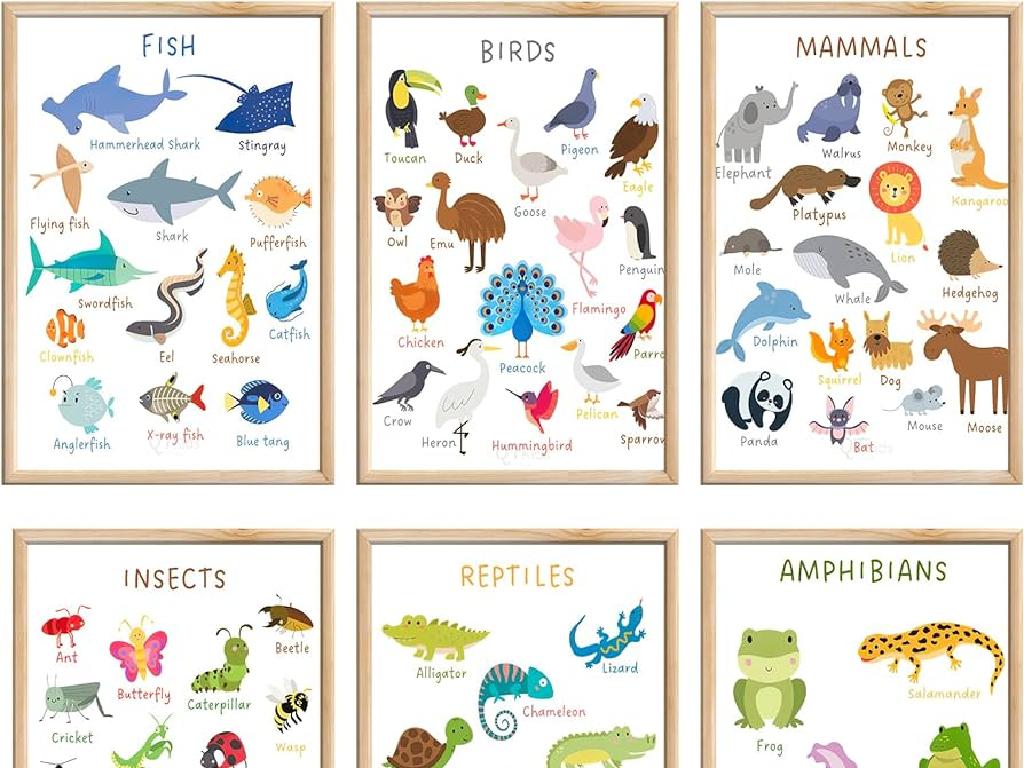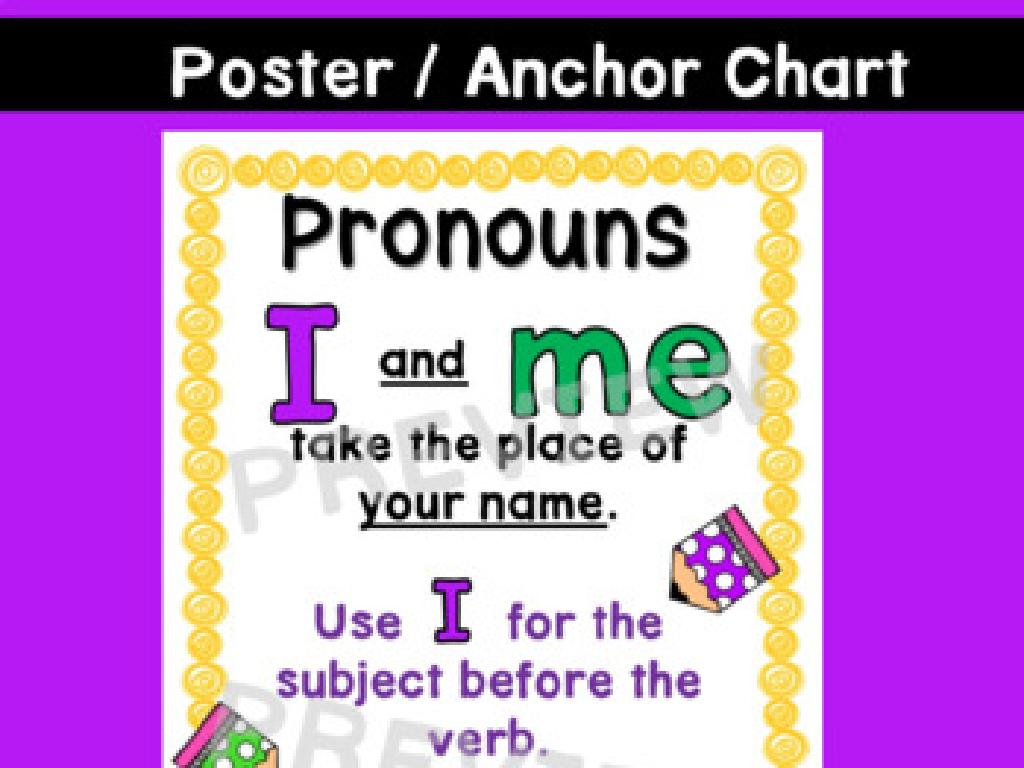Animal Cell Diagrams: Label Parts
Subject: Science
Grade: Fourth grade
Topic: Cells
Please LOG IN to download the presentation. Access is available to registered users only.
View More Content
Exploring the Animal Cell
– Cells as life’s building blocks
– Animal cells: A close look
– Observe the tiny structures that make up animal cells
– Key parts of animal cells
– Nucleus, cytoplasm, cell membrane, and more
– Functions of cell components
– Learn what each part does to keep the cell alive
|
This slide introduces the concept of cells as the fundamental building blocks of all living organisms, with a focus on animal cells. Begin by explaining that everything alive is made up of cells. Then, guide the students through the main components of an animal cell, such as the nucleus, cytoplasm, and cell membrane, and discuss their functions. Use diagrams to help visualize the parts of the cell. Encourage students to think about how each part contributes to the cell’s survival and function. This will set the foundation for understanding more complex biological processes and the importance of each cell component.
Exploring Animal Cells
– What is an animal cell?
– The basic unit of life in animals
– Key characteristics of animal cells
– They lack cell walls and have flexible membranes
– Functions of animal cells
– They perform essential tasks like energy production
– Importance of studying animal cells
– Understanding cells helps us know how animals grow and heal
|
This slide introduces the concept of animal cells to fourth-grade students. Begin with a simple definition, explaining that an animal cell is the basic building block of life in animals, much like bricks in a building. Highlight the unique characteristics of animal cells, such as the absence of a cell wall and the presence of a flexible membrane, which distinguishes them from plant cells. Discuss the various functions these cells perform, including energy production, waste removal, and reproduction. Emphasize the importance of animal cells in the context of growth, healing, and overall animal health. Encourage students to think about how every animal, including themselves, is made up of countless tiny cells working together.
Exploring Animal Cell Parts
– Cell Membrane: The Protector
– It’s like a security gate, keeping the cell safe.
– Mitochondria: The Powerhouse
– They’re like tiny power plants, creating energy.
– Nucleus: The Cell’s Brain
– It’s like the boss, controlling all cell activities.
– Understanding Cell Functions
|
This slide introduces students to the basic components of an animal cell. The cell membrane is the protective barrier that controls what goes in and out of the cell, similar to a security gate. Mitochondria are the organelles that produce energy for the cell, functioning like tiny power plants. The nucleus, often referred to as the brain of the cell, holds the cell’s DNA and directs all activities. Use this slide to explain the importance of each part and how they contribute to the cell’s overall function. Encourage students to think of the cell as a mini-city, with each organelle performing a specific job to keep the city running smoothly.
More Cell Parts: Understanding Their Functions
– Cytoplasm: The Cell’s Playground
– Gel-like fluid where organelles play
– Lysosomes: The Clean-Up Crew
– Break down waste, like a recycling center
– Endoplasmic Reticulum: The Factory
– Pathways where things are made and moved
– Ribosomes: The Workers
– Tiny machines that make proteins
|
This slide introduces students to more complex parts of the animal cell and their functions. The cytoplasm is described as a playground because it’s a space where cell parts, or organelles, exist and move around. Lysosomes are compared to a clean-up crew because they help break down waste materials and cellular debris. The endoplasmic reticulum is likened to a factory because it’s involved in the production and transport of proteins and other cell products. Ribosomes are the workers of this factory, as they are the sites where proteins are made. Encourage students to think of the cell as a mini-city, with each part performing a specific job to keep the city running smoothly. Use diagrams to visually represent each part and its function. This analogy helps students remember the roles of each cell part and how they contribute to the cell’s overall function.
Let’s Label the Animal Cell
– Identify cell’s major parts
– Nucleus, mitochondria, cytoplasm, and more
– Use diagram to find organelles
– Visual aid to spot each organelle in the cell
– Discuss each part’s function
– What role does each part play in the cell’s life?
– Labeling activity
|
This slide is aimed at helping fourth-grade students understand the basic structure and functions of an animal cell. Start by introducing the major parts of the cell, such as the nucleus, mitochondria, and cytoplasm. Use a clear diagram of an animal cell to help students visually locate each organelle. As you go through each part, discuss its function – for example, the nucleus is the control center of the cell, and mitochondria are the powerhouses that provide energy. The labeling activity will involve students using this information to label a diagram of an animal cell, reinforcing their understanding of cell anatomy and the role of each component. Provide guidance and ensure each student can identify and understand the function of at least the major organelles.
Animal Cell vs. Plant Cell
– Both have cell membranes
– Both contain a nucleus
– Plant cells have cell walls
– Unlike animal cells, plant cells have a rigid wall outside the membrane.
– Chloroplasts in plant cells
– Chloroplasts enable plants to photosynthesize, turning sunlight into food.
|
This slide aims to highlight the fundamental similarities and differences between animal and plant cells, which are both essential units of life. Both types of cells share several structures, such as the cell membrane that protects the cell’s contents and the nucleus which houses genetic material. However, plant cells have additional components like the cell wall, which provides structure and support, and chloroplasts, which are necessary for photosynthesis – a process that animal cells do not perform. Understanding these differences is crucial for students as it helps them grasp how structure is linked to function in living organisms. Encourage students to think about why these differences might exist and how they help each type of cell survive in its environment.
Class Activity: Create Your Own Animal Cell Model
– Gather materials for cell model
– Follow steps to build your cell
– Use playdough or clay for organelles, a large bowl for the cell body
– Label each part of your cell
– Identify and mark parts like the nucleus, mitochondria, and cell membrane
– Enjoy and be creative!
|
This activity is designed to help students learn about animal cell structures in a hands-on way. Provide a variety of materials such as playdough, clay, beads, or yarn for students to represent different cell organelles. Guide them through the steps to create their cell model, ensuring they understand the function of each part they are modeling. Encourage creativity in their representation but also emphasize the importance of accurate labeling. Possible variations of the activity could include using different materials, working in groups, or presenting their model to the class. The goal is for students to have a tangible understanding of cell anatomy and to reinforce their learning through an engaging and interactive project.
Review: Animal Cell Parts
– Recap cell part functions
– Review nucleus, mitochondria, etc. and their roles
– Open floor for questions
– What’s next in cell exploration?
– Hint at plant cells comparison
– Encourage curiosity and participation
– Ask: What part fascinates you most?
|
This slide aims to consolidate the students’ knowledge of animal cell parts and their functions. Begin with a brief recap, touching on the nucleus as the control center, mitochondria as powerhouses, etc. Open the floor for questions, allowing students to clarify any doubts. Introduce the upcoming topic, which may involve comparing animal cells to plant cells, to pique their interest. Encourage students to be inquisitive and participate actively, asking them which cell part they find most interesting and why. This engagement will help reinforce their understanding and make the transition to the next topic smoother.
Homework: Explore Animal Cells!
– Draw an animal cell at home
– Label each part of the cell
– Include nucleus, mitochondria, etc.
– Write about your favorite cell part
– Why is it your favorite? What does it do?
– Share your cell diagram next class
|
This homework assignment is designed to reinforce the lesson on animal cell structure. Students are tasked with drawing an animal cell, labeling its parts, and writing a paragraph about their favorite part of the cell, explaining its function and why they find it interesting. This activity will help students better understand the role of each cell component and personalize their learning experience. In the next class, students will have the opportunity to present their work, fostering a sense of pride in their efforts and enhancing public speaking skills. Provide examples of cell parts to label, such as the nucleus, cytoplasm, cell membrane, mitochondria, and endoplasmic reticulum. Encourage creativity in their drawings and thoughtfulness in their written paragraphs.


/mla_citation_example.jpg)



